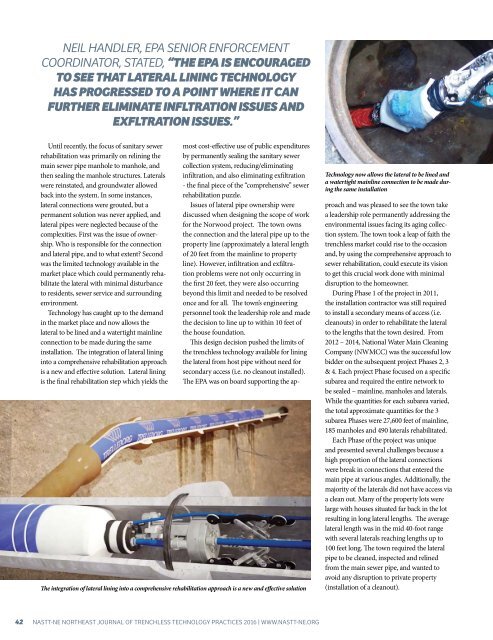PRACTICES
nastt-ne-journal-2016
nastt-ne-journal-2016
You also want an ePaper? Increase the reach of your titles
YUMPU automatically turns print PDFs into web optimized ePapers that Google loves.
NEIL HANDLER, EPA SENIOR ENFORCEMENT<br />
COORDINATOR, STATED, “THE EPA IS ENCOURAGED<br />
TO SEE THAT LATERAL LINING TECHNOLOGY<br />
HAS PROGRESSED TO A POINT WHERE IT CAN<br />
FURTHER ELIMINATE INFLTRATION ISSUES AND<br />
EXFLTRATION ISSUES.”<br />
Until recently, the focus of sanitary sewer<br />
rehabilitation was primarily on relining the<br />
main sewer pipe manhole to manhole, and<br />
then sealing the manhole structures. Laterals<br />
were reinstated, and groundwater allowed<br />
back into the system. In some instances,<br />
lateral connections were grouted, but a<br />
permanent solution was never applied, and<br />
lateral pipes were neglected because of the<br />
complexities. First was the issue of ownership.<br />
Who is responsible for the connection<br />
and lateral pipe, and to what extent? Second<br />
was the limited technology available in the<br />
market place which could permanently rehabilitate<br />
the lateral with minimal disturbance<br />
to residents, sewer service and surrounding<br />
environment.<br />
Technology has caught up to the demand<br />
in the market place and now allows the<br />
lateral to be lined and a watertight mainline<br />
connection to be made during the same<br />
installation. The integration of lateral lining<br />
into a comprehensive rehabilitation approach<br />
is a new and effective solution. Lateral lining<br />
is the final rehabilitation step which yields the<br />
The integration of lateral lining into a comprehensive rehabilitation approach is a new and effective solution<br />
Technology now allows the lateral to be lined and<br />
a watertight mainline connection to be made during<br />
the same installation<br />
most cost-effective use of public expenditures<br />
by permanently sealing the sanitary sewer<br />
collection system, reducing/eliminating<br />
infiltration, and also eliminating exfiltration<br />
- the final piece of the “comprehensive” sewer<br />
rehabilitation puzzle.<br />
Issues of lateral pipe ownership were<br />
discussed when designing the scope of work<br />
for the Norwood project. The town owns<br />
the connection and the lateral pipe up to the<br />
property line (approximately a lateral length<br />
of 20 feet from the mainline to property<br />
line). However, infiltration and exfiltration<br />
problems were not only occurring in<br />
the first 20 feet, they were also occurring<br />
beyond this limit and needed to be resolved<br />
once and for all. The town’s engineering<br />
personnel took the leadership role and made<br />
the decision to line up to within 10 feet of<br />
the house foundation.<br />
This design decision pushed the limits of<br />
the trenchless technology available for lining<br />
the lateral from host pipe without need for<br />
secondary access (i.e. no cleanout installed).<br />
The EPA was on board supporting the approach<br />
and was pleased to see the town take<br />
a leadership role permanently addressing the<br />
environmental issues facing its aging collection<br />
system. The town took a leap of faith the<br />
trenchless market could rise to the occasion<br />
and, by using the comprehensive approach to<br />
sewer rehabilitation, could execute its vision<br />
to get this crucial work done with minimal<br />
disruption to the homeowner.<br />
During Phase 1 of the project in 2011,<br />
the installation contractor was still required<br />
to install a secondary means of access (i.e.<br />
cleanouts) in order to rehabilitate the lateral<br />
to the lengths that the town desired. From<br />
2012 – 2014, National Water Main Cleaning<br />
Company (NWMCC) was the successful low<br />
bidder on the subsequent project Phases 2, 3<br />
& 4. Each project Phase focused on a specific<br />
subarea and required the entire network to<br />
be sealed – mainline, manholes and laterals.<br />
While the quantities for each subarea varied,<br />
the total approximate quantities for the 3<br />
subarea Phases were 27,600 feet of mainline,<br />
185 manholes and 490 laterals rehabilitated.<br />
Each Phase of the project was unique<br />
and presented several challenges because a<br />
high proportion of the lateral connections<br />
were break in connections that entered the<br />
main pipe at various angles. Additionally, the<br />
majority of the laterals did not have access via<br />
a clean out. Many of the property lots were<br />
large with houses situated far back in the lot<br />
resulting in long lateral lengths. The average<br />
lateral length was in the mid 40-foot range<br />
with several laterals reaching lengths up to<br />
100 feet long. The town required the lateral<br />
pipe to be cleaned, inspected and relined<br />
from the main sewer pipe, and wanted to<br />
avoid any disruption to private property<br />
(installation of a cleanout).<br />
42 NASTT-NE NORTHEAST JOURNAL OF TRENCHLESS TECHNOLOGY <strong>PRACTICES</strong> 2016 | WWW.NASTT-NE.ORG


